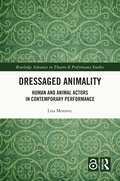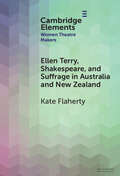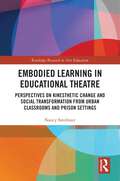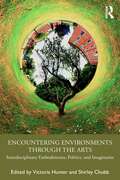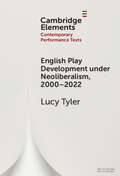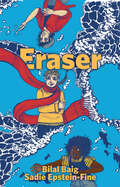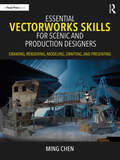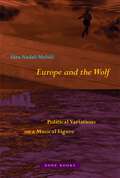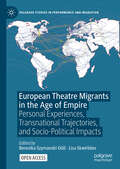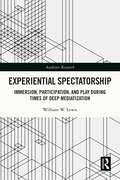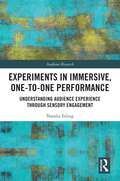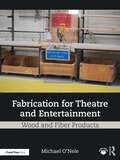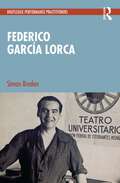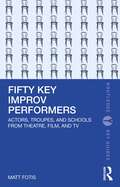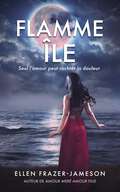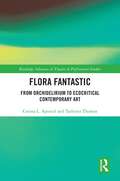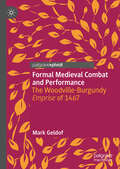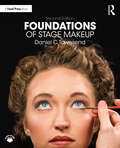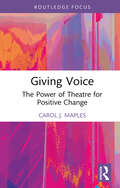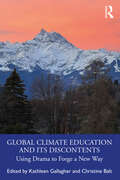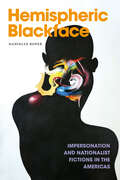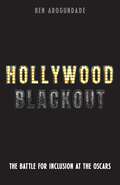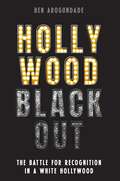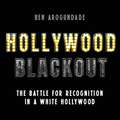- Table View
- List View
Dressaged Animality: Human and Animal Actors in Contemporary Performance (Routledge Advances in Theatre & Performance Studies)
by Lisa MoravecThe book applies a productive interdisciplinary lens of art history, performance, and animal studies for approaching political economy issues, critiquing anthropomorphic worldviews, and provoking thoughts around animal and human nature that spark impulses for an innovative performance aesthetics and ethics.It combines Marxist analysis with feminist and posthumanist methodology to analyse the relation between ‘societal dressage’ and ‘bodily animality’ that humans and animals share. Within this original theoretical framework, the book develops the concept of ‘dressaged animality’ as a mode of critique to analyse the social and political function of interdisciplinary forms of ‘contemporary performances.’Drawing on archival and primary research, the book theorises and historicises more than 15 performance practices in which animality is allegorically staged through by humans danced, real, or filmically mediated animals. It focuses on Rose English’s pioneering approach to performance-making as well as on overlooked performances by other renown and largely unknown American (Mike Kelley/Kate Foley, Robert Morris, Bruce Nauman, Yvonne Rainer, Diana Thater), British (Mark Wallinger, Rose English), and European artists (Tamara Grcic, Judith Hopf, Joseph Beuys, Bartabas) from the late 1960s until the late 2010s. While various types of artistic practice are framed as forms of critique (for example, protest art, interventionist strategies, institutional critique), the book maps an original performance theory in art which shows that contemporary artistic performances can also take up a critique of societal dressage.This study will be of great interest to students and scholars in art history, theatre, dance and performance studies, and ecology, as well as to artists and curators working with performance.
Ellen Terry, Shakespeare, and Suffrage in Australia and New Zealand (Elements in Women Theatre Makers)
by Kate FlahertyWhile the life and career of Ellen Terry (1847–1928) have attracted decades of attention from theatre historians and feminist biographers, one chapter remains hidden: Terry's tour of her solo Shakespeare lectures to Australia and New Zealand in 1914. This bold venture, made at the age of sixty-six, has been interpreted as an indication of Terry's declining physical andmental health following her 1906 Jubilee. Yet Terry claimed that 'while in Australia, although a woman, I am permitted to be a person', testifying affinity with the geopolitical region in which women had already achieved the right to vote in federal elections and to run for parliament. This Element undertakes the first comprehensive examination of the 1914 tour to reveal Terry's professional agency, her creative autonomy, her skilful navigation of ageist sexism, her eager receptivity to new natural environments, and her friendship with international opera star, Nellie Melba.
Embodied Learning in Educational Theatre: Perspectives on Kinesthetic Change and Social Transformation from Urban Classrooms and Prison Settings (Routledge Research in Arts Education)
by Nancy SmithnerThis book explores embodied teaching practices through applied and physical theatre, drawing extensively on the author’s rich experience teaching in diverse urban environments, including schools, colleges and prison settings.It presents a groundbreaking conceptualization of embodied practice aimed at fostering personal and social growth through educational theatre. Each chapter delves into theories of social transformation, supported by qualitative data from student reflections, to provide both theoretical and practical insights. These insights illustrate how physicalized pedagogy can be effectively used to engage students with socially transformative ideas and identities. It also emphasizes the significant role of the facilitator in this process, highlighting how they can create an environment that fosters ethical and multicultural awareness in both formal educational settings, such as classrooms, and informal settings, like community workshops. By promoting an ethos of inclusivity and ethical consideration, it argues that facilitators can help students navigate and engage with complex social issues through the medium of theatre.An accessible and compelling text, it aims to inspire educators to adopt innovative methods that promote deeper engagement and understanding among students.
Encountering Environments through the Arts: Interdisciplinary Embodiments, Politics, and Imaginaries
by Victoria Hunter Shirley ChubbThis edited collection of essays and artist reflections presents perspectives from arts and humanities researchers exploring how individuals and collectives engage with, relate to and experience environments. The term environment is broadly conceived in this volume and encompasses rural landscapes and nature spaces, urban and architectural sites, institutional, workplace and organisational spaces, domestic environments and public and private realms.Exploring what it means to encounter environments through embodied, artistic and reflexive practices, the essays and reflections draw on theoretical fields of feminist posthuman discourse, new materialism, anthropology, human geography, queer studies, performing and fine arts, art and health, psychology and ecological perspectives. Drawing on dialogues emerging from discursive border crossings between disciplines, Encountering Environments through the Arts includes contributions from the fields of dance, walking practice, sonic arts, visual art, cultural and human geography, somatic movement practice, poetry and architecture. This collection offers insights and reflections on environment and experience from a range of voices – established and emerging scholars, independent researchers and practitioner-researchers within and beyond the academy.Providing a truly interdisciplinary range of research that centres on notions of site-specific practice and experience, this is an invaluable contribution to performance studies and the wider field of arts and humanities. The reflective accounts and articulation of research methods and approaches make this volume ideal for undergraduate and postgraduate students as well as scholars and researchers of performance studies, dance and choreography studies, cultural studies, environmental humanities, arts and social sciences.
English Play Development under Neoliberalism, 2000–2022 (Elements in Contemporary Performance Texts)
by Lucy TylerEnglish Play Development under Neoliberalism, 2000–2022 is the first study of the institutionalising of English play development practices in the twenty-first century. It identifies the ways in which support for playwrights and text development increased beneficially during the 1990s and 2000s. It assesses bureaucratic institutional dynamics in key English producing houses as they were surveyed by two reports in 2009, and how these were experienced and transformed in the 2010s. The Element identifies in new play development innovations in the commodification and marketisation of new writing, the bureaucratisation of literary management, the structuring and restructuring of dramaturgy according to Fordist, then post-Fordist, conditions, and the necessity for commissioned artists to operate as neoliberal subjects. It concludes with attention to a liberatory horizon for play development in the English context. This title is also available as Open Access on Cambridge Core.
Eraser
by Bilal Baig Sadie Epstein-FineAn immersive experience, Eraser delves into the memories and fantasies of a classroom of students as they figure out who they want to be. Six students guide readers through their different journeys, taking them along to the cafeteria, change rooms, and playground, to the places where they feel safest and the most brave, vulnerable, and afraid. Afroze just moved to Canada from Pakistan and is struggling to fit in as a white-skinned gender-questioning convert to Islam. All Jihad wants is to be cool, but he struggles with the appearance of this new student who doesn’t look like any of the Muslims he knows. Noah’s brother just died, and he’s been avoiding processing his grief, which makes him lash out at his best friend, Eli. Eli doesn’t know how to support Noah, who he also harbours questioning feelings for. Whitney wants to live by her own rules in her own imaginary world, but she’s forced to deal with annoying kids like Tara. Tara loves school and getting straight As, but all the pressure she feels eventually adds up and she crumbles. Finding a balance between tough realities and honest fantasies, Eraser is an energetic and sentimental look at what it’s like to navigate differences and connections as a kid.
Essential Vectorworks Skills for Scenic and Production Designers: Drawing, Rendering, Modeling, Drafting, and Presenting
by Ming ChenEssential Vectorworks Skills for Scenic and Production Designers is an accessible textbook that covers the digital skills of 2D drawing, 3D modeling, rendering, drafting, and design presentation, providing aspiring designers with an invaluable toolkit to quickly and efficiently hone their craft.Modeled after learner-centered teaching practice and based on USITT drafting standards, this book is structured around six carefully selected core projects. It introduces key terms and commands, tools, techniques, and procedures for drawing, modeling, rendering, drafting, and design presentation with Vectorworks. Each chapter begins with key commands and a set of learning objectives that will be explored. The design exercises and projects that follow invite the reader’s active participation in the learning process. Along with step-by-step instructions, 240 illustrations (including student work samples), and three insightful interviews with professional designers, this book also contains open-ended projects that encourage the reader to explore new ways of scenographic expression and creatively apply commands and techniques to solve example design problems.This textbook is for use in scenic design, drafting, model making, and rendering courses in university theatre and media programs, and may be of interest to emerging professional scenic designers or scenographers for theatre, opera, and concert performances, production designers or art directors in film and television industries, themed exhibition designers, and theme park designers.Essential Vectorworks Skills for Scenic and Production Designers includes access to a wealth of online resources, including 15 videos with step-by-step instruction, six files of vwx or PDF formats for additional exercises and projects, and a video of student work samples.
Europe and the Wolf: Political Variations on a Musical Figure
by Sara Nadal-MelsióHow the work of several contemporary artists illuminates and challenges the policing of European borders and identityIn this stunningly original book, Sara Nadal-Melsió explores how the work of several contemporary artists illuminates the current crisis of European universalist values amid the brutal realities of exclusion and policing of borders. The &“wolf&” is the name Baroque musicians gave to the dissonant sound produced in any attempt to temper and harmonize an instrument. Europe and the Wolf brings this musical figure to bear on contemporary aesthetic practices that respond to Europe&’s ongoing social and political contradictions. Throughout, Nadal-Melsió understands Europe as a conceptual problem that often relies on harmonization as an organizing category. The &“wolf&” as an emblem of disharmony, incarnated in the stranger, the immigrant, or the refugee, originates in the Latin proverb &“man is a wolf to man.&” This longstanding phrase evokes the pervasive fear, and even hatred, of what is foreign, unknown, or beyond the borders of a community. The book follows the &“wolf&” in a series of relays between the musical, the visual, and the political, and through innovative readings of artworks—by, among others, Carles Santos, Pere Portabella, Allora&Calzadilla, and Anri Sala. Traversed by the musical, these artworks, as well as Nadal-Melsió&’s writing, present unstable symbolic and material ensembles in an array of variations of political possibilities and impossibilities that evade institutions intolerant of uncertainty and wary of diversity.
European Theatre Migrants in the Age of Empire: Personal Experiences, Transnational Trajectories, and Socio-Political Impacts (Palgrave Studies in Performance and Migration)
by Berenika Szymanski-Düll Lisa SkwirbliesThis open access edited volume constitutes the first historical study of the phenomenon of European theatre migration, and thus contributes in new and important ways to the formation of a historical discourse on theatre and migration. The hidden histories of European theatre migration that this book seeks to explore allow us to rethink global theatre history as a history of mobility with Europe as the point of departure rather than the point of arrival. It also allows the reader to challenge and to decenter a European self-understanding of insularity and a European cosmopolitanism ignorant of its imperial and colonial roots.
Experiential Spectatorship: Immersion, Participation, and Play During Times of Deep Mediatization (Audience Research)
by William W. LewisExperiential Spectatorship offers a lens for analyzing audience experience with(in) a variety of contemporary media. Using a broad-based perspective, this media includes participatory theatre, video games, digital simulations, social media platforms, alternate reality games, choose your own adventure narratives, interactive television, and a variety of other experiential performance events. Through a taxonomy that includes Immersion, Participation, Game Play, and Role Play the book guides the reader to understand the ways mediatization and technics brought about by digital technologies are changing the capacities and expectations of contemporary audiences. In their daily interactions and relations with their technologies, they become mediatized spectators. By reading these technologies' impacts on individual subjectivity prior to acts of spectatorship, one gains the tools to best describe how the spectator creates forms of relational exchange with their experential media.This book prepares the reader to think in a digital manner so they can best recognize how performance and spectatorship in the twenty-first century are evolving to meet the needs of future waves of spectators brought up in a postdigital world.
Experiments in Immersive, One-to-One Performance: Understanding Audience Experience through Sensory Engagement (Audience Research)
by Natalia EslingThis book investigates audience experience through the lens of sensory engagement in immersive, one-to-one performance. It presents a distinct, practice-based research (PBR) framework – a performance research ‘laboratory’ – designed to evaluate the effects on diverse audience experiences of two ‘sense-specific manipulations’: eye masks and touch. Through a qualitative analysis of responses from seventy-four individual audience participants, this book offers insight into how these popular ‘immersing’ strategies might be experienced. What do these strategies achieve? How do audience participants make sense of them? Do audience responses align with artistic intentions? And how does the PBR framework designed to address these questions influence the outcomes? Through an analysis of three sets of one-to-one performance experiments generating comparative data about the experience of sense-specific manipulation, this book proposes the utility of merging methodologies in artistic research with empirical audience research in theatre and performance studies. This study offers a new perspective on the value of sensory-focused, immersive, one-to-one experience as a means of resensitizing audience participants through performance.
Fabrication for Theatre and Entertainment: Wood and Fiber Products (Fabrication for Theatre and Entertainment)
by Michael O'NeleFabrication for Theatre and Entertainment: Wood and Fiber Products is a complete reference guide to the process of working with wood products for scenic and properties construction for theatre and entertainment arts.This book covers lumber product characteristics, layout methods for fabricators, and the tooling and machinery used to fabricate with lumber products. While there are references that demonstrate common scenic construction methods, furniture joinery, and commercial construction, this book also introduces methods for calibrating machinery and accurately configuring them for various construction tasks, helping entertainment fabricators ensure a repeatable, accurate finished product. Readers will be introduced to a wide range of tools and techniques, which will allow them to tackle both common issues and new challenges creatively and effectively.The book is intended as a resource for technical designers, technical directors, shop managers, master carpenters, and prop or scenic fabricators working in various parts of the entertainment industry, including film, television, theatre, themed entertainment, exhibits, and immersive installation art.To access full-color versions of the artwork, visit www.routledge.com/9781032593197.
Federico García Lorca (Routledge Performance Practitioners)
by Simon BredenLauded as one of the most important poets and playwrights of the twentieth century, Federico García Lorca was also an accomplished theatre director with a clear process and philosophy of how drama should be staged. Directing both his own work and that of others, Lorca was also closely involved in the rehearsals for productions of many of his plays, and from his own writings and those of his collaborators, a determined agenda to stimulate audiences and renovate theatre can be seen.This is the first book in English to fully consider Lorca as a director and his rehearsal methodology. The book combines:- A biographical account of Lorca’s work as a director and rehearsal leader, revealing his techniques and methods of approach texts;- An exploration of his key writings on and around theatre, drawing on his talks, play introductions, and some of the dramatic works themselves;- The first translation into English of his fragment Dragón;- A detailed discussion of Lorca’s key productions, Lope de Vega’s Fuente Ovejuna (1933) for La Barraca, and his own Yerma (1934).- Specific focus on the practical applications that we can draw from Lorca’s methods, both from what survives of his own work and from the accounts of his close collaborators.As a first step towards critical understanding, and as an initial exploration before going on to further, primary research, Routledge Performance Practitioners offer unbeatable value for today’s student.
Fifty Key Improv Performers: Actors, Troupes, and Schools from Theatre, Film, and TV (Routledge Key Guides)
by Matt FotisFifty Key Improv Performers highlights the history, development, and impact of improvisational theatre by highlighting not just key performers, but institutions, training centers, and movements to demonstrate the ways improv has shaped contemporary performance both onstage and onscreen. The book features the luminaries of improv, like Viola Spolin, Keith Johnstone, and Mick Napier, while also featuring many of the less well‑known figures in improvisation who have fundamentally changed the way we make and view comedy – people like Susan Messing, Jonathan Pitts, Robert Gravel, and Yvon Leduc. Due to improv’s highly collaborative nature, the book features many of the art form’s most important theatres and groups, such as The Second City, TJ & Dave, and Oui Be Negroes. While the book focuses on the development of improvisation in the United States, it features several entries about the development of improv around the globe. Students of Improvisational Theatre, History of Comedy, and Performance Studies, as well as practitioners of comedy, will benefit from the wide expanse of performers, groups, and institutions throughout the book.
Flamme Île: Seul l'amour peut rechercher la douleur
by Ellen Frazer-JamesonFlamme Île Par Ellen Frazer-Jameson Seul l’amour peut racheter la douleur. Dans un décor enchanteur et dramatique, "Flamme Île" raconte une histoire captivante d'amour, de trahison et de rédemption. Serena Perez, une star de la télévision riche et influente, se bat pour maintenir une image parfaite tout en affrontant les tempêtes de sa vie personnelle. Sa quête pour l'excellence sociale et ses ambitions professionnelles cachent des blessures profondes et des secrets douloureux. Alors qu'un ouragan menace de bouleverser sa prestigieuse collecte de fonds pour un candidat à la présidence, un événement inattendu la force à choisir entre sa carrière et les liens familiaux qu'elle a négligés. De l'élégance glamour de Miami Beach à l'intimité émouvante d'un hospice, cette saga explore les complexités de la famille, les sacrifices que nous faisons pour réussir et la force de l'amour dans les moments les plus sombres. Une œuvre pleine de drame, d'émotion et d'espoir qui captivera votre cœur et restera avec vous longtemps après avoir tourné la dernière page. Découvrez cette histoire poignante qui célèbre la résilience humaine et le pouvoir transformateur du pardon.
Flora Fantastic: From Orchidelirium to Ecocritical Contemporary Art (ISSN)
by Corina L. Apostol Tashima ThomasThis book delves deep into colonial botany, utilizing mediums such as historical investigation, cinema, photography, live performance, and installation art.Surveying perspectives from Europe, the U.S., Africa, Southeast Asia, Latin America, and the Caribbean, it positions plants—both native and foreign—as active participants and silent observers in colonial narratives. By viewing through the prism of visual and performance art, this book touches on diverse topics like the economic value of plants, traditional and Western medicine, state‑endorsed scientific endeavors, migration patterns of flora and people, bio‑contact areas, nationalistic views, and botanical diplomacy. It offers fresh insights into colonial botany’s multifaceted history, emphasizing the intricate interplay between Eastern, Western, and Southern nations during the twentieth century and its enduring impact today.Serving as an invaluable addition to the realms of art history, performance studies, botany, visual culture, decolonial initiatives, and environmental politics, this book arrives at a pivotal moment when its insights are most crucial.
Formal Medieval Combat and Performance: The Woodville-Burgundy Emprise of 1467
by Mark GeldofThis book collects together all contemporary and near-contemporary accounts of the 1467 emprise, a particular performative feat of arms, between Anthony Woodville, Lord Scales—brother of Elizabeth Woodville, wife of King Edward IV of England—and Antoine, &‘Grand Bastard of Burgundy,&’ natural son of Duke Philip &‘the Good&’ of Burgundy. Held at Smithfield, London, this emprise has long interested historians of chivalry because of the detailed accounts of its organization and the commentaries on the combats held over two days. Despite its familiarity to readers of late medieval English and European history, the accounts themselves have not historically been easily accessible, and several of them have never appeared in translation in English before now. This collection gathers those accounts, presents them in readable English editions, and gives historical contexts for their content.
Foundations of Stage Makeup
by Daniel C TownsendFoundations of Stage Makeup, Second Edition is a comprehensive exploration into the creative world of stage makeup.Step-by-step makeup applications paired with textual content create an enriching experience for future performers and makeup artists. Students will learn relevant history, color theory, makeup sanitation processes, and the use of light and shadow to engage in discussions about the aspects of professional makeup. Those foundations are then paired with a semester’s worth of descriptive, engaging makeup applications. Old age makeup, blocking out eyebrows, gory burns, and creating fantastical creatures are just a few of the rewarding techniques found in Foundations of Stage Makeup. This new edition features new chapters on basic prosthetic appliction and animal makeup, new information on historical makeup use, updates pertaining to industry-wide standards and practices, new images, and updated supporting material.This is the perfect book to use in Introduction to Stage Makeup courses.Foundations of Stage Makeup is complemented by makeup tutorials, a printable makeup chart, and an instructor’s manual with example assignments and tips to teaching each chapter, available at www.routledge.com/9781032664200.
Giving Voice: The Power of Theatre for Positive Change (ISSN)
by Carol J. MaplesThis book is a practical guide for using the power of theatre to address issues of oppression in areas such as race, ethnicity, LGBTQ+, gender, and sexual harassment.Giving Voice charts a roadmap for the process of establishing a troupe, including auditioning members, utilizing authentic source material, directing rehearsals, guiding mindful growth among troupe members, and facilitating an inclusive forum environment. Rooted in Augusto Boal’s Theatre of the Opressed and using the nationally recognized Missouri State University’s Giving Voice troupe as a model, this book provides guidance for customizing the program’s principles to meet the needs of your school, community, organization, or business. Giving Voice forums bring professional development to a new level. Applications include diversity and cultural awareness training in educational settings for students, staff, faculty, and administrators, as well as those in non-profit and for-profit organizations.This book provides a powerful and proven approach to creating a truly inclusive climate. It is a guidebook for accessible use in the secondary and university setting in theatre and performance studies. It has also been shown to be effective for businesses and other organizations.
Global Climate Education and Its Discontents: Using Drama to Forge a New Way
by Kathleen Gallagher Christine BaltThis innovative and practical book offers pedagogical tools to show how drama can be used in educational settings to advance a relational, action-oriented, interdisciplinary, and creative climate education attuned to the social and emotional effects of the climate emergency. Based on a six-year ethnographic research study taking place with teachers, artists, community leaders, and young people globally, and taking its lead from the following provocation – can performance become a site for new imaginaries for socio-ecological justice? – the book explores the unique conceptual and pedagogical ‘discontents’ of climate education across geographically and culturally distinct sites of learning. It also examines how artful engagement through drama pedagogies can open up more collective, critical, and hopeful forms of thinking and being.The book is divided into two sections. The first part of the book, Local engagements and encounters, consists of chapters that conduct an in-depth appraisal of the local artistic work from each site, examining how matters of socio-ecological justice are given fresh urgency and complexity through the application of performance as pedagogy. The second part of the book, Pedagogical and artistic innovations, offers substantive praxis chapters on the drama-based pedagogical methods employed in the research. In these chapters, the world-building capacities of theatre-making offer up new, performative pedagogical orientations to the climate emergency beyond those of critique.Global Climate Education and Its Discontents: Using Drama to Forge a New Way is valuable reading for scholars interested in the ontological and epistemological dimensions of the climate emergency, especially within and across the following fields: drama, theatre and performance studies, applied theatre and drama education, educational research, and children/childhood and youth studies. The book also invites a readership of teachers and teacher-educators who are interested in applying drama pedagogies in the classroom to explore matters of socio-ecological justice and the climate crisis.
Hemispheric Blackface: Impersonation and Nationalist Fictions in the Americas (Dissident Acts)
by Danielle RoperIn Hemispheric Blackface, Danielle Roper examines blackface performance and its relationship to twentieth- and twenty-first-century nationalist fictions of mestizaje, creole nationalism, and other versions of postracialism in the Americas. Challenging both the dominance of the US minstrel tradition and the focus on the nation in blackface studies, Roper maps a hemispheric network of racial impersonation in Peru, Bolivia, Colombia, Jamaica, Cuba, and Miami. She analyzes blackface performance in the aftermath of the turn to multiculturalism in Latin America, the emergence of modern blackness in Jamaica, and the rise of Barack Obama in the United States, showing how blackface remains embedded in cultural entertainment. Contending that the Americas are linked by repeating nationalist fictions of postracialism, colorblindness, and myths of racial democracy, Roper assesses how acts of impersonation mediate the ongoing power of these narratives and enable people to comprehend advancements and reversals in racial equality. Rather than simply framing blackface as liberatory or oppressive, Roper traces its emergence from a shared history of slavery and the varied politics of racial enjoyment throughout the hemisphere.
Hollywood Blackout: The battle for recognition in a white Hollywood
by Ben ArogundadeOn 29 February 1940, African American actor Hattie McDaniel became the first person of colour, and the first Black woman, to win an Academy Award. The moment marked the beginning of Hollywood's reluctant move toward diversity and inclusion. Since then, minorities and women have struggled to attain Academy Awards recognition within a system designed to discriminate against them. For the first time, Hollywood Blackout reveals the untold story of their tumultuous journey from exclusion to inclusion; from segregation to celebration. Author Ben Arogundade interweaves the experiences of Black actors and filmmakers with those of Asians, Latinos, South Asians, indigenous peoples and women. Throughout the decades their progression to the Oscars podium has been galvanized by defiant boycotts, civil rights protests and social media activism such as #OscarsSoWhite.Whether you are a film fan, history lover or diversity advocate, Hollywood Blackout is the quintessential choice for all those who wish to know the real story of Hollywood, the Oscars and the talents who fought to make change.
Hollywood Blackout: The battle for recognition in a white Hollywood
by Ben ArogundadeOn 29 February 1940, African American actor Hattie McDaniel became the first person of colour, and the first Black woman, to win an Academy Award. The moment marked the beginning of Hollywood's reluctant move toward diversity and inclusion. Since then, minorities and women have struggled to attain Academy Awards recognition within a system designed to discriminate against them. For the first time, Hollywood Blackout reveals the untold story of their tumultuous journey from exclusion to inclusion; from segregation to celebration. Author Ben Arogundade interweaves the experiences of Black actors and filmmakers with those of Asians, Latinos, South Asians, indigenous peoples and women. Throughout the decades their progression to the Oscars podium has been galvanized by defiant boycotts, civil rights protests and social media activism such as #OscarsSoWhite.Whether you are a film fan, history lover or diversity advocate, Hollywood Blackout is the quintessential choice for all those who wish to know the real story of Hollywood, the Oscars and the talents who fought to make change.
Hollywood Blackout: The battle for recognition in a white Hollywood
by Ben ArogundadeOn 29 February 1940, African American actor Hattie McDaniel became the first person of colour, and the first Black woman, to win an Academy Award. The moment marked the beginning of Hollywood's reluctant move toward diversity and inclusion. Since then, minorities and women have struggled to attain Academy Awards recognition within a system designed to discriminate against them. For the first time, Hollywood Blackout reveals the untold story of their tumultuous journey from exclusion to inclusion; from segregation to celebration. Author Ben Arogundade interweaves the experiences of Black actors and filmmakers with those of Asians, Latinos, South Asians, indigenous peoples and women. Throughout the decades their progression to the Oscars podium has been galvanized by defiant boycotts, civil rights protests and social media activism such as #OscarsSoWhite.Whether you are a film fan, history lover or diversity advocate, Hollywood Blackout is the quintessential choice for all those who wish to know the real story of Hollywood, the Oscars and the talents who fought to make change.
Hollywood Blackout: The battle for recognition in a white Hollywood
by Ben ArogundadeOn 29 February 1940, African American actor Hattie McDaniel became the first person of colour, and the first Black woman, to win an Academy Award. The moment marked the beginning of Hollywood's reluctant move toward diversity and inclusion. Since then, minorities and women have struggled to attain Academy Awards recognition within a system designed to discriminate against them. For the first time, Hollywood Blackout reveals the untold story of their tumultuous journey from exclusion to inclusion; from segregation to celebration. Author Ben Arogundade interweaves the experiences of Black actors and filmmakers with those of Asians, Latinos, South Asians, indigenous peoples and women. Throughout the decades their progression to the Oscars podium has been galvanized by defiant boycotts, civil rights protests and social media activism such as #OscarsSoWhite.Whether you are a film fan, history lover or diversity advocate, Hollywood Blackout is the quintessential choice for all those who wish to know the real story of Hollywood, the Oscars and the talents who fought to make change.
